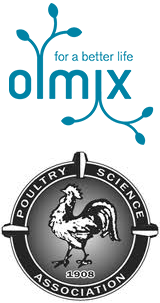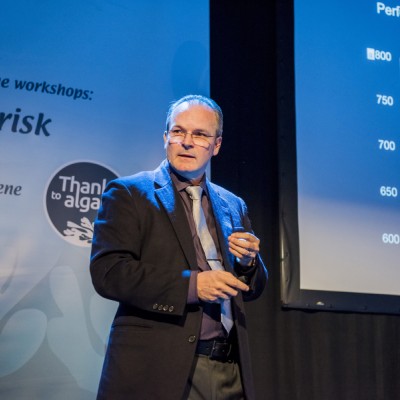
SYMPOSIUM OLMIX
2019 PSA Annual Meeting
18-07-2019 Montreal, Québec | Canada
Un symposium Olmix dans le programme officiel du PSA Annual Meeting
Téléchargez ici le programme officiel (pdf) >>
N’oubliez pas de vous inscrire pour la réunion sur le site web PSA Annual Meeting >>
Gestion du risque mycotoxine et Santé Intestinale en volaille
Importance en production avicole et solutions innovantes de soutien.

Modérateur
Mme Danièle Marzin
Directrice Marketing Olmix Group
Ce symposium évaluera l’importance du système immunitaire et de la santé intestinale en production de volaille et informera la communauté avicole du risque lié aux mycotoxines et de ses effets sur la santé intestinale et l’immunité. On y examinera les dernières technologies de diagnostic disponibles pour évaluer l'exposition des animaux aux mycotoxines, les marqueurs de la santé intestinale, la notion de niveau de risque, puis seront passées en revue les méthodes de prévention et de modulation du système immunitaire, permettant de soutenir la productivité grâce à un bon suivi du statut immunitaire et des supplémentations innovantes naturelles dans l’aliment.18
jui
Développement du système immunitaire en volaille
8:00 - 8:40
Prof. Dr. Med. Vet Bernd Kaspers
Professeur en physiologie animale – Université de Munich (Allemagne)
Le système immunitaire aviaire présente des caractéristiques uniques déterminées génétiquement. Les conditions environnementales post-éclosion et la colonisation bactérienne de l’intestin jouent un rôle important dans la maturation du système immunitaire, tandis que l’impact de la nutrition reste mal compris.
Coût d’une immunité altérée et conséquences sur le terrain
8:40 - 9:20
Prof. Dr. Filip Van Immerseel
Chercheur à l’Université de Gand (Belgique)
De nos jours, la classification des organes importants est en train de changer ; l'intestin est devenu de plus en plus important, en partie à cause de son implication dans les fonctions immunitaires. Pour obtenir de bonnes performances, il est nécessaire d’évaluer à la fois le coût d’une réponse immunitaire altérée et le coût de l'activation du système immunitaire.
Toxicité des mycotoxines : notion de niveau de risque et interaction entre les fusariotoxines au niveau de l’intestin.
9:20 - 10:00
Dr. Isabelle Oswald
INRA – Unité TOXALIM, France
Parmi les mycotoxines, la fumonisine B1 et le déoxynivalénol ont un impact important sur les performances zootechniques. Ces mycotoxines ne sont pas seulement toxiques localement pour l'intestin, mais dérèglent de nombreuses fonctions intestinales et nuisent à la réponse immunitaire locale. Cela se traduit par une toxicité systémique entraînant de nombreux symptômes. La contamination des aliments par les mycotoxines altère également la fonction de barrière de l'intestin, entraînant la translocation des bactéries dans l'intestin et donc les infections intestinales et systémiques.Pause café

Gérer les mycotoxines à la vitesse de la
lumière : Application de la technologie NIR à l’analyse des mycotoxines
10:30 - 11:10
Prof. Carlos Mallmann
Laboratoire d’Analyses Mycotoxicologiques (LAMIC, Brésil)
L'analyse des mycotoxines est un outil essentiel dans la gestion du risque mycotoxine dans les aliments pour animaux. Le contrôle des matières premières doit être précis et rapide pour constituer un outil décisionnel efficace. Récemment, la technologie rapide, simple et peu coûteuse pour la détection des mycotoxines qui utilise la spectroscopie proche infrarouge - NIR a été développée et constitue une alternative très prometteuse pour le secteur de l’alimentation animale.
Revue des stratégies de détoxification des mycotoxines dans l’aliment pour animaux en Europe
11:10 - 11:40
Mme. María Ángeles Rodríguez
Chef produit For Feed Olmix
Une stratégie pour réduire l'exposition des animaux aux mycotoxines consiste à réduire la biodisponibilité des mycotoxines en incorporant divers agents de détoxification des mycotoxines dans l’aliment. Face à l'abondance d'agents de détoxification disponibles, des méthodes de screening sont nécessaires pour évaluer leur efficacité et sélectionner les matériaux appropriés. On observe une grande variabilité des résultats en fonction de la méthode et de la mycotoxine utilisées.
Table Ronde
11:40
Et aussi…
Communications orales présentées dans d’autres sessions du 2019 PSA Annual Meeting
16
jui
Des polysaccharides d’algues pour améliorer la santé intestinale
Séance : 5-Minute Abstract Presentations
14:55 - 15:00
Mme Danièle Marzin
Directrice Marketing Olmix Group
RÉSUMÉ
María García1, María Angeles Rodríguez1, Mustapha Berri2, Christel Rousseaux3 and Pi Nyvall-Collen1
1Olmix Group, Bréhan, France; 2INRA, Nouzilly, France; 3Intestinal Biotech Development, Lille, France
The cell wall of marine algae is mainly composed of water soluble sulfated polysaccharides with several biological activities such as modulation of the immune response and reinforcement of gut barrier function. The present study aimed at assessing the ability of different seaweed extracts on improving gut health. The first part of the word tested a specific extract from green algal Ulva sp to upregulate the expression of immune mediators and the molecular mechanisms underlying this immunomodulatory activity by identifying the cell receptor and the signaling pathways involved. The second part of the work focussed on the the potential enhancement properties of a red algal extract from Solieria Chordalis on intestinal integrity using in vitro cell models HT-29 MTX and Caco-2 cells, under physiological and inflammatory conditions. Results showed that Ulva sp extract has the capacity to upregulate the expression of immune mediators: TNFα, CCL20, IL-1α, TGF-β that are involved in cell differentiation and proliferation, recruitment of immune cells and anti-inflammatory activities. Ulva sp extract interacts with TLR4 and TLR2 and leads to rapid activation of transcription factors PI3K and NF-κB. The red algal extract was shown to upregulate the expression of different target genes related to claudin-2, ZO-1 and ZO-2. The red algal extract upregulates the expression of mucin targeted genes: MUC4, MUC2, MUC5B and MUC5AC. The combination of both algal extracts can reinforce gut health targeting barrier function which is the first line of mucosal defense and via modulation of local innate and adaptive immune responses and induction of anti-inflammatory activities. The use of macroalgal sulfated polysaccharides can play an important role within the reduction of antibiotics in farms.
18
jui
Effet d’un complexe algues-argile sur l’activité des enzymes digestives et les performances de poulets de chair nourris avec un aliment maïs-soja.
Séance : Metabolism and Nutrition: Feed Additives IV
13:00 - 13:15
Mme. María Ángeles Rodríguez
Chef produit For Feed Olmix
RÉSUMÉ
Marie Gallissot1, Rodrigo Jacob2, Luiz Fernando Albino2, Horacio Rostagno2, Raquel Pereira1, Mariel Tavares1, Maria Angeles Rodriguez*1
1Olmix, Bréhan, France; 2Department of Animal Science, University of Viçosa, Viçosa, Minas Gerais, Brazil
Improving feed digestibility is a multi-faceted issue in animal nutrition. It contributes to improve livestock farming sustainability, by optimizing the use of available resources and by reducing environmental emissions, while increasing farming profitability. This study was set up to evaluate the effect of supplementing an algae-clay complex (ACC) on digestive enzyme activity and growth performance of broiler chickens fed with a corn-soy diet. The experiment was conducted at the Federal University of Viçosa (Brazil). Six hundred and sixty 1-day-old Cobb 500 male chicks were randomly distributed to 3 treatments with 10 replicates per treatment and 22 chicks per experimental unit, allocated to 1 of 3 groups receiving different diets: the standard diet (C) based on corn and soybean meal, the test diet 1 (T1), being the standard diet supplemented with 0.1% of ACC, and the test diet 2 (T2), being the standard diet supplemented with 0.2% of ACC. Animal’s performance was evaluated by measuring weight gain, feed consumption and feed conversion ratio for each feeding phase. Moreover, duodenum samples were collected at 35 days, two hours after the last feeding, from 3 chickens per replicate (30 chickens/treatment) to perform digestive enzyme activity assays. The activity of amylase (using starch) and chymotrypsin (using BTEE substrate) were measured by spectrophotometer in kinetic assay. Results showed a tendency to increase weight gain for groups T1 and T2 compared to control, though it was not statistically significant Feed conversion ratio was decreased in both test groups compared to control during the grower period (-4% and -5% respectively, P=0.043) and the whole period (-3%, P=0.038). These results were comforted by an increased activity of amylase (+25%, P<0.01) and chymotrypsin (+13 to 20%, P<0.001) in the duodenum in T1 and T2 groups compared to the control group, reflecting an improved capacity of digestion of the diet by birds supplemented with the algae-clay complex. No dose effect of the ACC product was observed. In the end, this study shows a positive effect of the algae-clay complex on feed efficiency of broiler chickens fed a corn-soy based diet. Its use at 0.1% of the feed seems the most interesting to improve performance and profitability.

